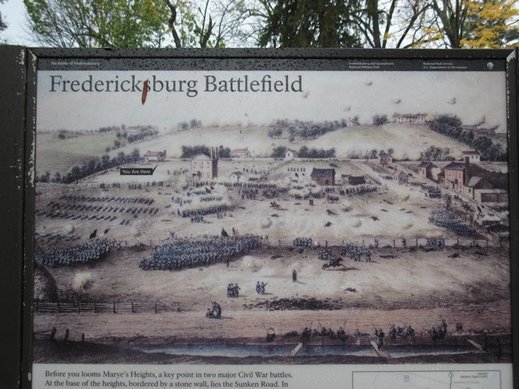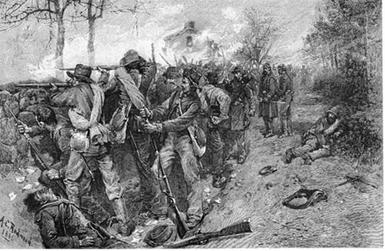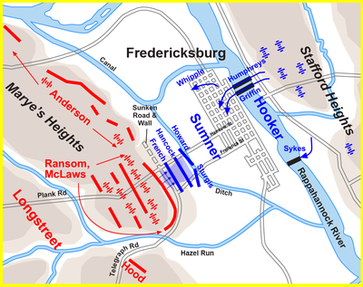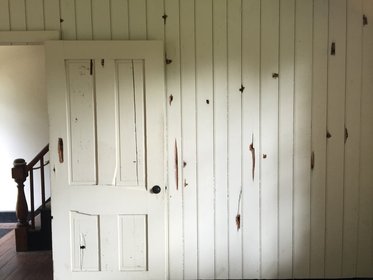Lesson Plan: Fredericksburg, VA Digital Field Trips with Janie Lynn Panagopoulos
Lesson Plan
Subject: Fredericksburg, Virginia: The Wall, Dec. 11-14, 1862
Objectives and Goals:
• Students will become familiar with Fredericksburg, Virginia's visual and historical location.
• Student will gain historical knowledge of the Battle of Fredericksburg, Dec. 11-14, 1862
Vocabulary:
• battlefield
• engineers
• pontoon bridge
• snipers
• artillery
• Telegraph road
• stone wall
• rifles
• carnage
• truce
• retreat
• victory
Anticipatory Set (30 minutes)
• Tell students briefly what this lesson is about.
• Ask students to define the dates of the Civil War and the date of the Battle of Fredericksburg.
• Ask students if they are familiar with the name of Fredericksburg.
Direct Instruction (45 minutes)
Summary:
On November 14th, 1862, Union Gen. Burnside, now commander of the Army of the Potomac, arrived near Fredericksburg, VA. This move was made in hopes of a possible Union march to overtake the Confederate Capitol in Richmond, Virginia.
If General Burnside and his men could attack immediately, there was a great possibility of a victory in Fredericksburg and a quick march upon Richmond. However, this was not going to happen.
Burnside was on the wrong side of the Rappahannock River, which was swollen because of winter rains. He needed to cross 100,007 men into Fredericksburg, and he would need bridges to accomplish this.
Contacting Washington, he requested immediate help of equipment and engineers to build pontoon bridges, but weeks passed before help arrived.
Gen. Lee, by early December, gathered over 72,000 Confederates and set up camp in Fredericksburg on Marye’s Heights and waited for the slow-moving Union troops to cross the river and attack the town.
On December 11, five pontoon bridges were completed, and troops crossed over under a sniper attack. Burnside tried several frontal attacks on Marye’s Heights over the next 48 hours, with no luck and staggering casualties.
On December 15, Burnside retreated, calling for a truce to collect Union bodies from the field, which Gen. Lee granted.
The Confederate victory was the first of many false hopes for Gen. Burnside. He was replaced in duty in January 1863.
Guided Practice: (45 minutes)
• Have students view Digital Field Trip: Fredericksburg The Wall, Dec. 11-14, 1862.
• Discuss the video.
• View again, if necessary, to look for different information.
• Some of the photos and video clips are historic. Some are current; could they tell the difference?
• How far away from Richmond is Fredericksburg?• How far from Richmond from Washington D.C.?
• What mistakes did Gen. Burnside make concerning this battle?
• View primary source documents and websites included in the plan.
Closure (30 minutes)
• Ask students:
1. What is the name of the river Gen. Burnside and the Union troops needed to cross?
2. How do pontoon bridges work?
3. Should Burnside have rowed his men across the river into Fredericksburg in November? Why? Why not?
4. The name Marye’s Heights suggests that Gen. Lee positioned his men on land high above Fredericksburg. Was this a good idea? Why? Why not?
5. The Confederates used “The Wall” as a position to hide behind to fire at the Union soldiers. If you were a soldier, what position would you want to take? Should I become a Union soldier on an open field or a Confederate soldier behind a wall? Explain.
6. This was one of Gen. Lee’s first significant victories. Do you think he was happy or sad after the battle? (Gen. Lee was considered very compassionate and kind and did not like war.) Your thoughts?
7. Do you think those who died in Fredericksburg were transported home for their funerals?
View Quiz
Fredericksburg - Quiz
Quiz: Fredericksburg: The Wall
1. Was General Ambrose Burnside a Union officer or a Confederate officer?
2. What was the name of the river that General Burnside needed his troops to cross?
Potomac Rappahannock Grand River (circle one)
3. What year did the Battle of Fredericksburg take place?
1859 1862 1962 (circle one)
4. Why did General Burnside not attack Fredericksburg in November when he had a better chance to win. Explain.
5. Why was Marye’s Heights considered a good position for the Confederate army?
6. Why is the “high” ground generally always a better location for a battle?
7. General Robert E. Lee was protecting what city from the Union army?
Washington, DC Richmond Chicago
8. With so many men wounded and dead on the field of battle, did Gen. Lee allow the Union army to retrieve their bodies?
Yes No
Lesson Plan
Subject: Fredericksburg, Virginia: The Wall, Dec. 11-14, 1862
Objectives and Goals:
• Students will become familiar with Fredericksburg, Virginia's visual and historical location.
• Student will gain historical knowledge of the Battle of Fredericksburg, Dec. 11-14, 1862
Vocabulary:
• battlefield
• engineers
• pontoon bridge
• snipers
• artillery
• Telegraph road
• stone wall
• rifles
• carnage
• truce
• retreat
• victory
Anticipatory Set (30 minutes)
• Tell students briefly what this lesson is about.
• Ask students to define the dates of the Civil War and the date of the Battle of Fredericksburg.
• Ask students if they are familiar with the name of Fredericksburg.
Direct Instruction (45 minutes)
Summary:
On November 14th, 1862, Union Gen. Burnside, now commander of the Army of the Potomac, arrived near Fredericksburg, VA. This move was made in hopes of a possible Union march to overtake the Confederate Capitol in Richmond, Virginia.
If General Burnside and his men could attack immediately, there was a great possibility of a victory in Fredericksburg and a quick march upon Richmond. However, this was not going to happen.
Burnside was on the wrong side of the Rappahannock River, which was swollen because of winter rains. He needed to cross 100,007 men into Fredericksburg, and he would need bridges to accomplish this.
Contacting Washington, he requested immediate help of equipment and engineers to build pontoon bridges, but weeks passed before help arrived.
Gen. Lee, by early December, gathered over 72,000 Confederates and set up camp in Fredericksburg on Marye’s Heights and waited for the slow-moving Union troops to cross the river and attack the town.
On December 11, five pontoon bridges were completed, and troops crossed over under a sniper attack. Burnside tried several frontal attacks on Marye’s Heights over the next 48 hours, with no luck and staggering casualties.
On December 15, Burnside retreated, calling for a truce to collect Union bodies from the field, which Gen. Lee granted.
The Confederate victory was the first of many false hopes for Gen. Burnside. He was replaced in duty in January 1863.
Guided Practice: (45 minutes)
• Have students view Digital Field Trip: Fredericksburg The Wall, Dec. 11-14, 1862.
• Discuss the video.
• View again, if necessary, to look for different information.
• Some of the photos and video clips are historic. Some are current; could they tell the difference?
• How far away from Richmond is Fredericksburg?• How far from Richmond from Washington D.C.?
• What mistakes did Gen. Burnside make concerning this battle?
• View primary source documents and websites included in the plan.
Closure (30 minutes)
• Ask students:
1. What is the name of the river Gen. Burnside and the Union troops needed to cross?
2. How do pontoon bridges work?
3. Should Burnside have rowed his men across the river into Fredericksburg in November? Why? Why not?
4. The name Marye’s Heights suggests that Gen. Lee positioned his men on land high above Fredericksburg. Was this a good idea? Why? Why not?
5. The Confederates used “The Wall” as a position to hide behind to fire at the Union soldiers. If you were a soldier, what position would you want to take? Should I become a Union soldier on an open field or a Confederate soldier behind a wall? Explain.
6. This was one of Gen. Lee’s first significant victories. Do you think he was happy or sad after the battle? (Gen. Lee was considered very compassionate and kind and did not like war.) Your thoughts?
7. Do you think those who died in Fredericksburg were transported home for their funerals?
View Quiz
Fredericksburg - Quiz
Quiz: Fredericksburg: The Wall
1. Was General Ambrose Burnside a Union officer or a Confederate officer?
2. What was the name of the river that General Burnside needed his troops to cross?
Potomac Rappahannock Grand River (circle one)
3. What year did the Battle of Fredericksburg take place?
1859 1862 1962 (circle one)
4. Why did General Burnside not attack Fredericksburg in November when he had a better chance to win. Explain.
5. Why was Marye’s Heights considered a good position for the Confederate army?
6. Why is the “high” ground generally always a better location for a battle?
7. General Robert E. Lee was protecting what city from the Union army?
Washington, DC Richmond Chicago
8. With so many men wounded and dead on the field of battle, did Gen. Lee allow the Union army to retrieve their bodies?
Yes No



